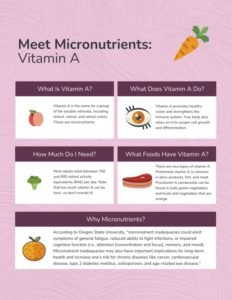Micronutrients: Vitamin A
Now that we've learned about the need for micronutrients and what exactly micronutrients are, it's time to take a closer look at our first micronutrient... vitamin A.What Is It? Vitamin A is "the name of a group of fat-soluble retinoids, including retinol, retinal, and retinyl esters" (source).What Does It Do? Vitamin A promotes healthy vision and strengthens the immune system. Your body also relies on it for proper cell growth and differentiation.How Much Do I Need? Most adults need between 700 and 900 retinol activity equivalents (RAE) per day. You can get more details in this handy chart!
* A quick note from Lynn Grieger, RDN, CDCES, CPT, CHWC: "Vitamin A is stored in the liver, and because it is fat soluble, excessive amounts can build up and lead to toxicity. Unless your physician recommends otherwise, stay under the Tolerable Upper Intake Level (UL) for the best health."
What Foods Are Rich in this Micronutrient? There are actually two different types of vitamin A.The first, preformed vitamin A, is common in dairy products, fish, and meat.The second type of vitamin A, provitamin A carotenoids (like beta carotene), can be found in leafy green vegetables, and both fruits and vegetables that are orange or yellow. Think carrots, sweet potatoes, apricots, and cantaloupe.And that's an introduction to the amazing micronutrient, vitamin A. Here's a printable handout that you can download today! If you'd like to learn more about vitamin A, don't miss this series from Lynn Grieger, RDN, CDCES, CPT, CHWC...
If you'd like to learn more about vitamin A, don't miss this series from Lynn Grieger, RDN, CDCES, CPT, CHWC...
- What is Vitamin A and What Does It Do?
- How Much Vitamin A Do I Need?
- Sources of Vitamin A: Food vs Supplements
References:
- https://ods.od.nih.gov/factsheets/VitaminA-HealthProfessional/
- https://foodandhealth.com/how-much-vitamin-a/